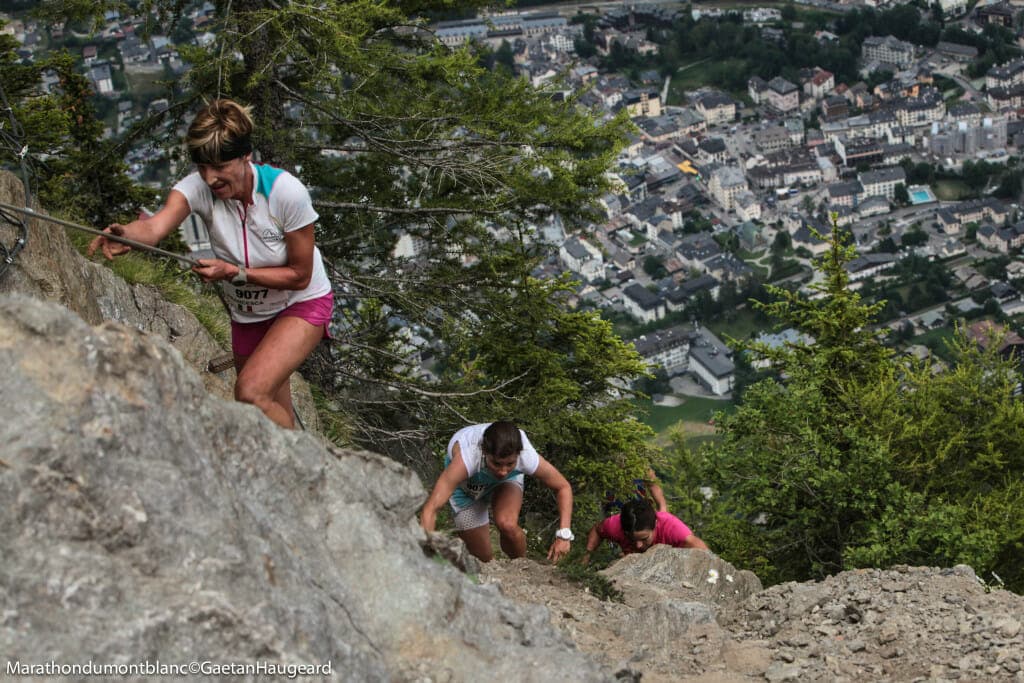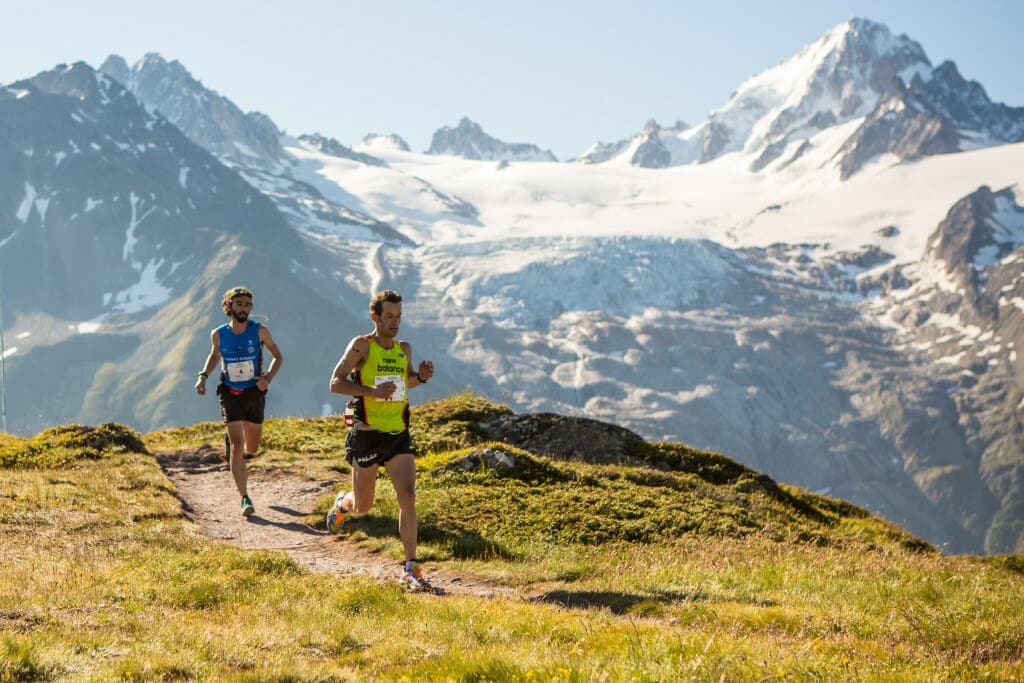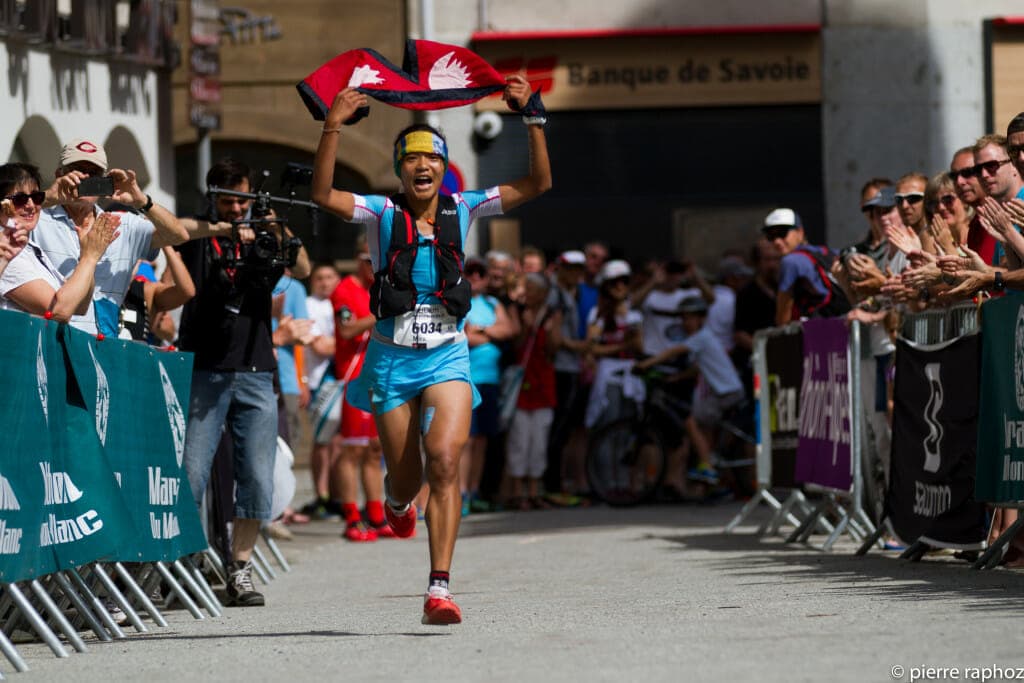
Is Chamonix the Trail Running Capital of the World?
I’m staring at a second hand that’s moving with an implausible smoothness. As the hand sweeps around the dial one last time, the color on the clock face changes from red to orange.
Something about the scene feels familiar. I flash back to my childhood, watching alpine ski racers during ABC’s Wide World of Sports with my brothers.
Quickly after turning orange, the clock flashes green—my signal to take my turn at Chamonix’s famed Kilomètre Vertical.
The crowd in Place du Triangle de l’Amitié roars its approval as another trail runner faces the technical wall that is Plan Praz.
“Only in Chamonix,” I think.

*****
Chamonix’s trail running moment might be happening right now. Walk through town in June, July, especially August and even September, and you’ll get an odd sensation. Trail running shorts and singlets seem as common as jeans and t-shirts. Salomons, Hokas, Innov-8s and Montrails are de rigeur. You can finish a run in town with your trail running vest still on, and not feel sheepishly awkward. You are among your tribe in a way that happens only here. Even the town’s Mayor, Eric Fournier, is a trail runner.
How did this come to pass? How did Chamonix become what is arguably the world’s epicenter for trail running?
The answer starts, in part, nearly four decades ago. 1979 was the first year of a 23-km trail race called the Cross du Mont-Blanc. The route was well-chosen, wending its way steadily up the long Chamonix valley, through the woods, or “les Bois,” past the village of Argentière, to Montroc, finally reaching the far end of the valley at the hamlet known as Tré le Champ, and then wrapping up with a climb to the stunning South Balcony of the Chamonix valley—all the while keeping Mont Blanc within sight, through to the finish at Plan Praz.
One of the of most famous trail races in Europe, the Cross remains iconic as ever. Alain Bustin, one of the key organizers for the event, puts the Cross in a category with the acclaimed Swiss trail race Sierre-Zinal. It’s hard to argue with that. The two races were the forebearers of a new mountain sport that would flourish for decades in the Alps and across the world.
That first year, 292 runners took part. Popularity steadily increased, and today the Cross has expanded to five events, including the Vertical Kilometer, a 10-km sprint along the valley floor, a half-marathon, marathon, and an 80-km ultra. The Ultra and Vertical Kilometer are part of the internationally-sanctioned Skyrunning series. The weekend’s activities have outpaced the local CMBM club that once hosted it, and today is managed by the professional Chamonix Club des Sports. The Club des Sports estimates that 21,000 trail runners, along with their friends and family, descend on the valley for the events each year. And still, the races are growing in popularity—2016’s races saw the introduction of a lottery to select participants, a first.

In 2003, with the Mont Blanc Marathon long established, Michel and Catherine Poletti launched Ultra-Trail du Mont-Blanc (UTMB)—a daring 165-kilometer race around the trails of the Mont Blanc massif. A remarkable 700 runners toed the starting line for their inaugural event, and numbers grew quickly, as the idea of circumnavigating Mont Blanc in one push captured the imagination of trail runners around the globe. Today, there’s an alphabet soup of UTMB-engineered races: the original event, and now CCC, TDS, PTL, and OCC—all varying lengths, but each finishing in the old village of Chamonix, and incorporating trails around at least some of Mont Blanc. “UTMB week,” as it’s now known in Chamonix, is now one of the busiest periods of the year for the town, and includes a multi-day trail running expo, talks, press conferences, events with elite trail runners, and countless industry gatherings. Together, UTMB week and the Mont Blanc Marathon Skyrunning weekend serve as sweaty, drama-filled bookends for the busy summer of trail running in the Chamonix region.
*****
During the lull between its marquee events, Chamonix continues to host a steady drumbeat of trail running. On any given day, it’s not uncommon to find trail runners out on the Vertical Kilometer course during their lunch hour, running up to the mid-station on the Aiguille du Midi tram, or to the Mer de Glace at Montenvers. Driving much of that daily activity is the CMBM, the Club Mont Blanc Marathon. Founded more than thirty years ago and now counting over 200 members, the club is one of the oldest mountain running organizations in the world. Twice a week, CMBM hosts training runs. Each weekend, club members head to races in the region. There are frequent social gatherings, professional coaching, training lectures, and much more.
It all starts with the trails, of course, and Chamonix excels here, too. There is some of the best mountain running to be found anywhere in the world in Chamonix—and a seemingly limitless supply of it. One can run all summer in Chamonix valley, and not even scratch the surface. You can run to high mountain cabins, past glaciers, and scramble up technical routes so exposed you wonder at the dubious ingenuity of the trail builder who dreamt it up.

With all of these pieces in place, it was only logical that top athletes and others in the trail running world would start moving to the Chamonix valley. The level of competition here is higher than anywhere else in the world. Kilian Jornet, Emelie Forsberg, Dawa Sherpa and a host of other internationally-known trail runners call the valley home year-round. And, as UTMB week approaches, their numbers swell, with an influx of elite runners from around the world. Each settles into his or her routines, exploring terrain in advance of one evening late in August, when the starting gun goes off in Place du Triangle, and they begin their personal odysseys around Mont Blanc.
None of this has been lost on the tourism office that powers the Chamonix Valley, which now markets the valley as the “Vallée du Trail.” A trail-running website shows what routes are open, recommended trail runs throughout the valley, and includes a substantial amount of supporting information. How many towns have a website dedicated to trail running? There’s more coming, too—this summer, British guidebook publisher Cicerone will release its first-ever guide to trail running in Chamonix, Trail Running: Chamonix and the Mont Blanc Region.
*****
Each year, Chamonix saves one of its great trail running events for the end of the season: as the snows begin to work their way down from the peaks, it’s time for Trail Des Aiguilles Rouges. While UTMB and the Skyrunning races bring in talent from far afield, Trail Des Aiguilles Rouges has a warm, friendly, and “locals first” feel about it. Organized by CMBM, the 50 km with 4,000 meters of climbing course is a local favorite, with a course that alternates annually over three different routes. Starting at 4:30 a.m. from (of course!) Place du Triangle de l’Amitié, last year’s route climbed for 10 km to the tram station at Flégère, and stayed largely above tree line, following the quiet trails across the valley from Mont Blanc, the snowy massif always over one’s shoulder. The event defines the French word chaleureuse, with a warm and inviting spirit all its own shared among the volunteers, onlookers, and participants alike.

Chamonix may very well be trail running’s world capital. It might also be trail running’s Mecca, Vatican City, Dharmsala, and Jerusalem—a place every devout trail runner should make a pilgrimage at least once in his or her life, if work, family, savings, and health align to make it happen. No deity will confer otherworldly benefits upon the pilgrim who sets foot in Chamonix, but for once in your life, you can walk through town wearing your running vest, and you’ll feel right at home.
Related Stories:
Redlining in Chamonix: The Vertical Kilometer
Kilian, Mira, Alex, and 21,000 Others: Chamonix’s Skyrunning Weekend
CMBM: The Club at the Heart of Trail Running in Chamonix
Courmayeur, to Champex, to Chamonix: Impressions from running the CCC